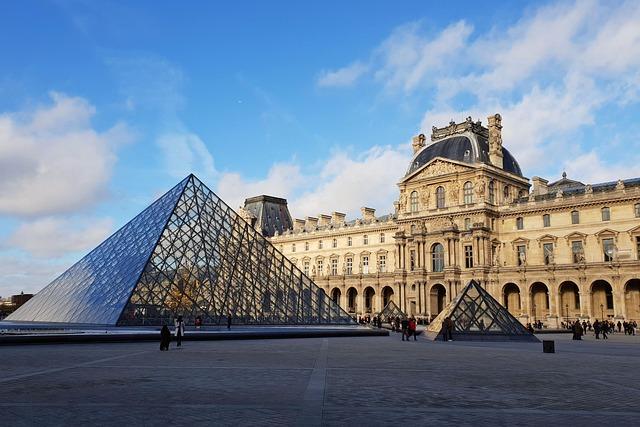Two suspects in the high-profile Louvre heist have “partially admitted” their involvement, according to statements from the prosecutor’s office. The revelations come as authorities intensify their investigation into the daring theft at the iconic Paris museum, which shocked the art world and raised urgent questions about security measures. This development marks a significant step forward in the case, as law enforcement continues to piece together the circumstances surrounding the incident and identify all parties involved.
Suspects Offer Partial Confession in High-Profile Louvre Theft
Authorities revealed Thursday that two individuals suspected in the audacious Louvre museum theft have made partial admissions during questioning. According to the prosecutor, while the suspects stopped short of a full confession, they acknowledged involvement in certain aspects of the heist. Investigators believe this partial cooperation could be pivotal in unraveling the complex web of the crime, which has captured global attention due to the artwork’s cultural and monetary value.
Key details emerging from the statements include:
- Planning phase: Both suspects concede to discussing logistics and roles but deny orchestrating the entire scheme.
- Access to restricted areas: They partially admit entering off-limits sections of the museum, raising questions about security protocols.
- Names undisclosed: The suspects remain tight-lipped about accomplices, complicating the broader investigation.
| Aspect | Suspect 1 Admission | Suspect 2 Admission |
|---|---|---|
| Planning Involvement | Discussed entry routes | Denied key role |
| Accessed Museum | Entered utility passages | Confirmed presence in galleries |
| Accomplices | Refused to disclose | Refused to disclose |
Prosecutor Details Evidence Linking Suspects to Iconic Art Heist
Concrete evidence presented by the prosecutor revealed a compelling connection between the two suspects and the infamous Louvre art heist, which stunned the world earlier this year. Key items seized during searches included:
- Replica security badges used for unauthorized access
- Detailed blueprints of the museum’s layout, highlighting vulnerable entry points
- Encrypted communications referencing the timing and execution of the theft
In addition to physical evidence, testimonies from eyewitnesses and expert analysts have strengthened the case, outlining the suspects’ roles in the operation. The prosecutor emphasized that both suspects have partially admitted their involvement,
| Evidence Type | Description | Impact on Case |
|---|---|---|
| Physical Artifacts | Security badges, lockpicks found during raids | Direct link to museum access |
| Blueprints | Detailed floor plans with escape routes | Corroborates suspect planning |
| Communication Logs | Encrypted messages discussing heist timeline | Supports organized effort claim |
Security Lapses at the Louvre Under Renewed Scrutiny After Incident
The latest developments in the Louvre incident have thrust the museum’s security measures back into the spotlight. Authorities revealed that two suspects involved in the heist have partially admitted to their roles, prompting questions about the adequacy of existing surveillance and vetting protocols. This admission has sparked renewed debate over whether the Louvre’s current system is equipped to deter or swiftly respond to sophisticated theft attempts.
Experts and officials have highlighted several potential vulnerabilities, including:
- Inconsistent camera coverage along critical access points.
- Insufficient staffing during late hours.
- Delayed response times in prior security alerts.
| Issue | Potential Impact | Recommended Action |
|---|---|---|
| Camera Blind Spots | Unmonitored entry points | Install additional high-resolution cameras |
| Understaffed Shifts | Delayed threat detection | Increase night shift personnel |
| Slow Emergency Response | Opportunity for theft | Implement rapid alert systems |
Recommendations for Strengthening Museum Security Protocols Revealed
In the aftermath of the daring Louvre heist, authorities and museum officials have prioritized a comprehensive reassessment of security measures across major cultural institutions. Critical gaps identified during the investigation have led to proposals emphasizing advanced surveillance integration and enhanced staff training. Experts recommend deploying AI-powered intrusion detection systems capable of real-time behavioral analysis, combined with biometric access controls to restrict unauthorized entry points.
Additionally, a multi-layered approach involving community engagement and cross-agency coordination has been championed to anticipate and mitigate future threats effectively. Key recommendations include:
- Routine security audits leveraging third-party specialists
- Installation of redundant power backups for critical security hardware
- Implementation of encrypted communication channels between museum security teams and local law enforcement
- Enhanced visitor screening protocols without compromising accessibility
| Recommendation | Expected Impact |
|---|---|
| AI Surveillance Systems | Enhanced threat detection accuracy |
| Biometric Access Control | Prevention of unauthorized access |
| Staff Security Training | Improved response times and protocols |
In Retrospect
As investigations continue, authorities are seeking to piece together the full scope of the audacious Louvre theft and the roles played by the suspects. The partial admissions mark a significant development in a case that has captured global attention, underscoring the ongoing challenges faced by cultural institutions in safeguarding priceless works of art. Further details are expected as prosecutors delve deeper into the motives and methods behind one of the most high-profile art crimes in recent history.




